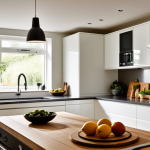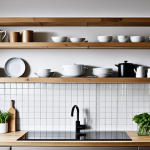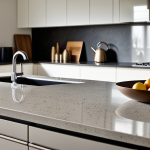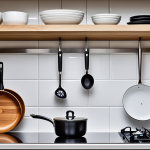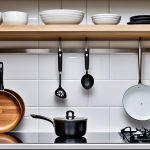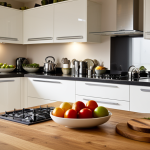Understanding the Slimmer Kitchen Aesthetic
In recent years, the slimmer kitchen design has gained popularity, reflecting a minimalist approach that aligns with modern trends. This aesthetic focuses on creating functional and uncluttered spaces by emphasizing simplicity and efficiency. Importantly, it incorporates the principles of clean lines, neutral color palettes, and sleek finishes, offering a sophisticated yet understated look.
Key Characteristics of a Slimmer Kitchen
A slimmer kitchen aesthetic is defined by several distinctive features:
Have you seen this : How can open shelving enhance a narrow UK kitchen?
- Minimalist Décor: Emphasizing minimal ornamentation and using essential elements helps achieve a tidy, purposeful environment.
- Streamlined Layouts: Careful planning ensures that space is maximized, with a clear flow that avoids unnecessary complexity.
- Efficient Use of Space: Implementing clever storage solutions and decluttering techniques, these kitchens focus on keeping surfaces free and open.
Differences in UK Kitchen Styles
Compared to traditional styles often found in the UK, which may include ornate details and heavier furniture, contemporary kitchen designs opt for lighter materials and a more airy feel. While traditional setups might favor wood finishes and intricate craftsmanship, modern UK kitchen styles lean towards sleek cabinetry and innovative materials, creating a space that feels both contemporary and timeless. Embracing these trends can not only enhance the aesthetic of a home but also improve its functionality, making everyday tasks simpler and more enjoyable.
Practical Design Tips
To embrace a slimmer kitchen aesthetic, selecting the right elements plays an essential role in maintaining a streamlined, minimalist atmosphere. One of the first steps involves choosing a cohesive color palette. Opt for neutral tones like whites, grays, and earth tones, which provide a clean backdrop that amplifies the sense of space.
Also read : How Can a Slimmer UK Kitchen Transform Your Daily Cooking Experience?
Lighting is another crucial factor. Incorporating a mix of task and ambient lighting can enhance a minimalist kitchen by highlighting key areas without overwhelming the space. Consider under-cabinet lighting to maintain a sleek look while improving functionality.
When it comes to cabinetry and countertops, select designs that emphasize simplicity. Handleless cabinets and integrated appliances contribute to a clutter-free appearance. For countertops, materials such as quartz or sleek laminate surfaces can offer a polished finish that complements the overall minimalist décor.
Together, these elements can significantly enhance your kitchen’s aesthetic while ensuring it remains functional and pleasing to the eye.
Innovative Storage Solutions
Exploring innovative storage solutions can transform a kitchen’s functionality, especially when adopting a slimmer design aesthetic. These strategies do not just create more space but also enhance the overall minimalist appeal.
Hidden Storage Options
Incorporating hidden storage is key to maintaining a clean, uncluttered look. Consider integrated appliances and pull-out pantries that maximize utility without overwhelming visual space. Concealed compartments within benches or islands can also house less frequently used items, ensuring surfaces remain tidy.
Multi-functional Furniture
Using multi-functional furniture expands usability while saving space. Opt for tables that double as prep stations, or stools with storage capacity. Such pieces not only optimize space but also align with the minimalist ethos by reducing furniture quantity without sacrificing function.
Vertical Space Utilization
Leverage vertical space for added storage. Installing high shelves or using tall cabinetry can hold items that are not needed daily, freeing up lower areas. Additionally, wall-mounted pot racks and magnetic strips efficiently utilize wall space, decluttering countertops and enhancing kitchen accessibility.
Recommended Products and Materials
When designing a slimmer kitchen, the choice of materials and products plays a vital role in achieving the desired aesthetic. Opt for modern kitchen materials that offer both style and functionality. For instance, quartz is a popular choice for countertops due to its sleek finish and durability, aligning well with the minimalist aesthetic.
In combination with these materials, focusing on sustainable products is increasingly important. Sustainable options not only enhance the kitchen’s visual appeal but also contribute to eco-friendly living. Look for materials that are recyclable or sourced from renewable resources to support environmental conservation.
Material Recommendations
- Quartz: This material is renowned for its durability and modern look, perfect for countertops.
- Bamboo: A sustainable choice for flooring or cabinetry, offering a warm, natural finish.
- Stainless Steel: Ideal for appliances due to its sleek, reflective surface and easy maintenance.
UK Brands and Sustainability
In the UK, numerous brands offer products that cater to the slimmer kitchen design trend. For example, Howdens and Magnet Kitchens are well-regarded for their range of minimalist and sustainable offerings. When selecting kitchen elements, consider brands that prioritize environmental responsibility.
Embracing these sustainable products and modern kitchen materials not only aligns with contemporary styles but ensures your kitchen contributes positively to the environment. Always vet the sustainability credentials of materials and brands to make informed decisions that align with your design and ecological values.
Case Studies of Successful Transformations
Exploring kitchen transformation examples provides valuable insights into achieving a successful slimmer kitchen redesign. In the UK, several before and after transformations showcase the effectiveness of adopting minimalist principles.
Notable Kitchen Transformations
One such transformation involved a compact urban apartment in London. The challenge was to improve functionality without sacrificing style. The solution focused on implementing sleek, integrated appliances and opting for handleless cabinetry to maintain a clean line. This approach not only maximized space but also enhanced the aesthetic, demonstrating the power of embracing minimalist kitchen trends.
Key Strategies and Their Impacts
The use of a neutral color palette played a crucial role in these transformations. By using whites and grays, spaces appeared larger and more open, reflecting light and creating an airy atmosphere. Additionally, the incorporation of multi-functional furniture, such as islands that serve as both dining and preparation areas, emphasized space-saving solutions and contributed to a streamlined environment.
Successful Features in the UK Context
Across different case studies, the emphasis on decluttering and efficient storage was consistent. For example, utilizing vertical space and hidden compartments facilitated organization and the seamless integration of personal touches without overwhelming the design. This strategy resonates with the slimmer kitchen design ideology, reinforcing that simplicity and efficiency can coexist beautifully.
By analyzing these case studies, homeowners and designers can draw inspiration and practical ideas to overcome common design challenges. These transformations illustrate that with thoughtful planning and innovative kitchen design tips, creating a functional and aesthetically pleasing minimalist kitchen is achievable.
Addressing Common Challenges
Designing a slimmer kitchen aesthetic can present several kitchen design challenges, particularly when balancing style with functionality. Common obstacles include limited space, which necessitates overcoming obstacles such as creating sufficient storage and maintaining a tidy appearance.
To tackle these challenges, consider practical solutions that maximize usability. For instance, modular elements like stackable containers and collapsible furniture pieces offer flexibility and adaptability. These innovations help manage clutter without sacrificing practicality, essential for a minimalist environment.
Additionally, look into resources and support available in the UK to assist with kitchen redesign projects. Engaging professional design services or seeking guidance from specialized design workshops can provide valuable insights. Leveraging expertise ensures that design decisions are both aesthetically pleasing and functional, enhancing the overall kitchen experience.
Visual Inspiration
Finding kitchen design inspiration is essential when aiming to achieve a minimalist visuals aesthetic. In recent UK trends, sleek and simplistic designs are prevalent, capturing the essence of a slimmer kitchen design. These spaces emphasize clean lines and open areas, presenting an inviting and efficient backdrop for modern living.
Incorporating images into your design process can provide clarity and vision. Visiting popular online platforms such as Pinterest or Instagram allows you to explore curated examples of trending aesthetics and seek ideas that align with your preferences. Local showrooms also offer a tactile experience, where you can see and feel materials, helping to guide informed decisions.
Imagery has the power to spark creativity, offering kitchen design inspiration that might not be immediately obvious through other means. Harnessing these resources can lead to a cohesive minimalist kitchen design that not only meets functional needs but also elevates your home’s aesthetic.

